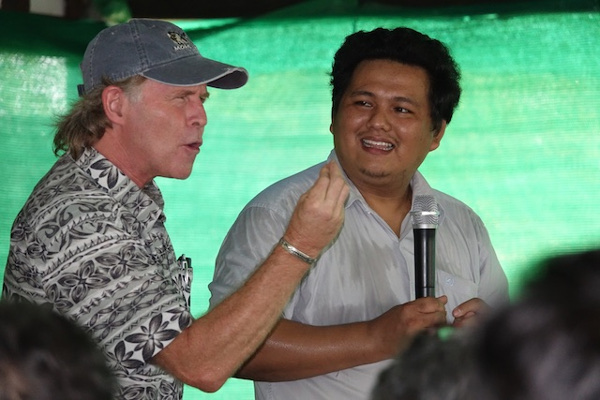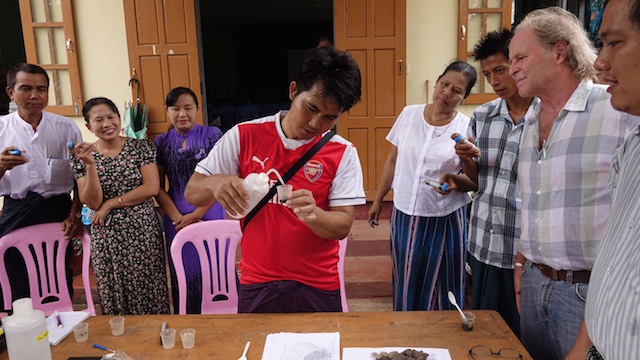
Volunteer Post
Building Resilience Through Improved Soil Quality
Drs. Jonathan Deenik and Glen Fukumoto
Winrock volunteers, like Dr. Jonathan Deenik and Dr. Glen Fukumoto, are helping to #endhunger by building farmers’ resilience through improved soil fertility management and composting applications. On a recent technical assistance assignment in Myanmar, the volunteers had the opportunity to work closely with two farmer organizations. The organizations attracted approximately 130 farmers, local government agents, and NGO professionals to the workshops and demonstrations; covering topics on soil fertility management, livestock waste management, and composting.
Dr. Deenik is a soil fertility expert and defines soil fertility “as the ability of the soil to supply essential plant nutrients and soil water in adequate amounts and proportions for plant growth and it is the foundation of productive, vibrant cropping systems. Soils, however, vary dramatically in their ability to store and supply elements essential for good crop growth. A sandy soil has limited capacity to store and supply plant nutrients whereas a finer soil with proportionately more clay will typically store and supply more nutrients. Soil fertility assessment is typically conducted through soil testing, which involves a series of chemical analyses to determine soil nutrient availability.
On this assignment in Hmawbi Township, I provided training in soil fertility assessment to two sets of farmer groups. Training participants at both sites brought soils from their respective farms and we tested the soils for pH (acidity) and available nitrate, phosphorus and potassium using my mobile soil testing equipment. The reflectoquant® technology uses different test strips for nitrate (N), phosphate (P) and potassium (K) coupled with a portable spectrophotometer to acquire concentration values for each nutrient. The participants went through the extraction and filtering steps, and then used the test strips and the spectrophotometer to the assess NPK status of their soils.
The farmers easily grasped the simple procedures and eagerly brought their soil samples forward for testing. With results for their soils in hand, I also provided them with the appropriate knowledge to interpret the test results and make fertilizer recommendations. After compiling the results, I highlighted the fact that many of the farmer’s soil samples were acidic to very acidic. Soils from paddy rice fields tended to show low nutrient status whereas soils from intensively managed vegetable fields were typically higher in nutrients – especially phosphorus. On the soils with low nutrient status, I presented some options for appropriate soil amendments including compost, manure, and synthetic fertilizers and presented some simple calculations to estimate the amount of amendment to add. In cases where soils had high nutrients, I emphasized to the farmers that fertilizer additions in these soils could be reduced to prevent nutrient loss to the environment with considerable savings to the farmer.
Access to simple, rapid, and reliable soil testing will have far-reaching impacts improving the livelihoods of rural Myanmar farmers empowering them to make sound fertilizer decisions that increase crop production while protecting soil and water resources.”

Dr. Fukumoto is an animal science specialist whose work focuses on on-farm projects in co-composting and nutrient management data collection. He describes composting as “one of the great wonders of the biological world. It is a natural process of aerobic microbial degradation of organic matter resulting in a stable and valuable soil amendment.
During the second workshop series, we discussed the possibility of including a compost demonstration with Dr. Thet Khaing, Project Management and Communication Specialist for the Winrock International Asia F2F Myanmar field office. Dr. “TK”, as we affectionately call him, is a Doctor of Veterinary Medicine and provides volunteers with wealth of knowledge about all things Myanmar – from culture and history to arts and crafts, and recommendations to the best restaurants in town. The host farm was eager to support the last-minute addition of a compost demonstration to the workshop agenda. With the farm manager, I discussed the logistics of the demonstration: dimensions and design of the compost bin, requirements for carbon and nitrogen materials, water, and tools that were needed to build the compost pile. Everything was purchased, gathered and ready the next day.

I worked with the farm crew, mostly through crude hand signals, and we completed the coolest compost bin I’ve worked on: woven bamboo side panels, custom-made bamboo aeration pipes, and a bamboo structural frame. Rice husks were used as the carbon resource and the nitrogen was provided by poultry manure. I had hoped for a beautiful day for the outdoor demonstration; well, at least no rain during the build. Thankfully, it didn’t rain during the demonstration, but working in the hot and humid weather with my shoes anchored in the sticky clay mud, and being surrounded by over 70 eager farmer participants, many seeing a compost pile being built for the first time, was just another great experience of delivering practical information and introducing innovative and age-old technologies for rural agricultural development.
The recycling of farm by-products and livestock waste through simple on-farm composting systems can help to replace a portion of the chemical fertilizers and improve the biological health of the soils to improve crop production, as well as to reduce the pollution potential of animal manure runoff into water resources in the region. In addition, the compost can be an integral part of the nutrient management plan of farms considering a transition to organic farming systems.”
